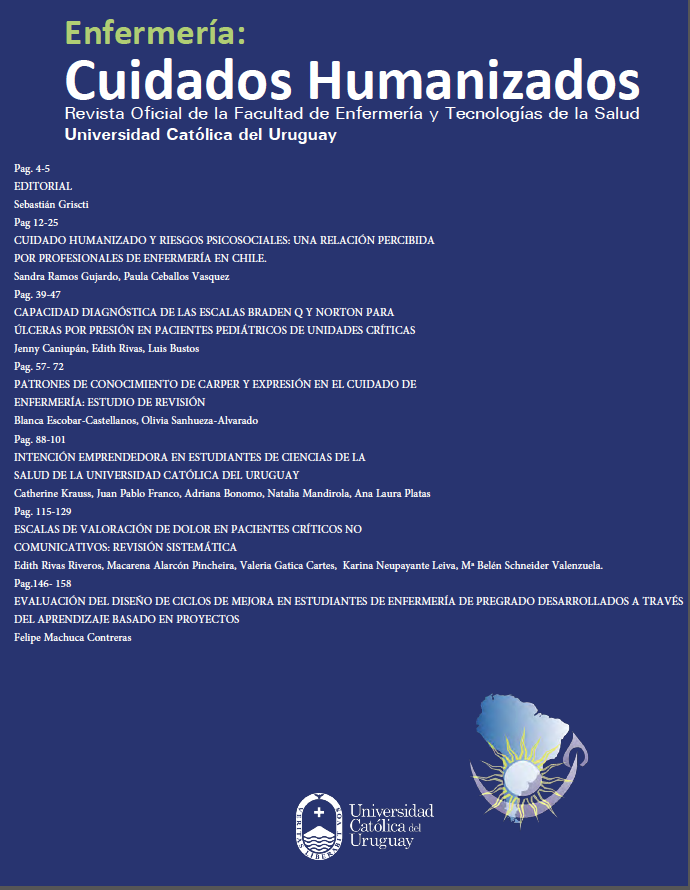DECISION MAKING ON REFRACTORY PAIN IN A YOUNG ONCOLOGICAL PATIENT
DOI:
https://doi.org/10.22235/ech.v8i1.1796Keywords:
Pain, Critical management, Palliative Care, SedationAbstract
The vast majority of cancer patients in advanced stages feel pain. Most are controlled with analgesics following the WHO analgesic ladder. However, a percentage of patients persist feeling pain. These are patients with difficult-to-control pain who often benefit from interventional measures. An even smaller percentage of patients keep on feeling pain as a refractory symptom despite adequate therapeutic measures. In these cases, palliative sedation is indicated. We present the case of a young patient with refractory pain who required palliative sedation in a palliative care unit of a private institution in Montevideo.
Downloads
References
2 Paredes, M. Qué hacer ante un dolor de difícil y rebelde. Paliativos sin Fronteras. Internet 2010. (Consultado 12 de julio de 2018) disponible en: http://paliativossinfronteras.org/wp-content/uploads/Dolor-dif%C3%ADcil-Marin.pdf
3 Krikorian, A. & Limonero, J. T. (2015). Factores asociados a la experiencia de sufrimiento en pacientes con cáncer avanzado. Avances en Psicología Latinoamericana, 33(3), 423-438.
4 A.S. Strömgren,M. Groenvold,M.A. Petersen,D. Goldschmidt,L. Pedersen,M. Spile. Pain characteristics and treatment outcome for advanced cancer patients during the first week of specialized palliative care, J Pain Symptom Manage., 27 (2004), pp. 104-113
5 R.G. Twycross. The terminal care of patients with lung cáncer, Postgrad Med J., 49 (1973), pp. 732-737.
6 Van den Beuken M.H. Everdingen,J.M. De Rijke,A.G. Kessels,H.C. Schouten,M. Van Kleef,J. Prevalence of pain in patients with cancer: A systematic review of the past 40 years, Ann Oncol., 18 (2007), pp. 1437-1449.
7 Di Maio,C. Gridelli,C. Gallo,L. Manzione,L. Brancaccio, S. Barbera. Prevalence and management of pain in italian patients with advanced non-small-cell lung cancer Br J Cancer., 90 (2004), pp. 2288-2296.
8 A.S. Strömgren,M. Groenvold,M.A. Petersen,D. Goldschmidt,L. Pedersen,M. Spile. Pain characteristics and treatment outcome for advanced cancer patients during the first week of specialized palliative care, J Pain Symptom Manage., 27 (2004), pp. 104-113.
9 C.E. DeSantis,C.C. Lin,A.B. Mariotto,R.L. Siegel,K.D. Stein,J.L. Kramer. Cancer treatment and survivorship statistics, 2014, CA Cancer J Clin., 64 (2014), pp. 252-271.
10 S. Mercadante,F. Fulfaro, World health organization guidelines for cancer pain: A reappraisal , Ann Oncol., (2005), pp. v132-v135.
11 H. Breivik,N. Cherny,B. Collett,F. De Conno,M. Filbet,A.J. Foubert.
Cancer-related pain: A pan-european survey of prevalence, treatment, and patient attitudes, Ann Oncol., 20 (2009), pp. 1420-1433.
12 M.H. Van den Beuken-van Everdingen,J.M. De Rijke,A.G. Kessels,H.C. Schouten, M. Van Kleef,J. Patijn. Prevalence of pain in patients with cancer: A systematic review of the past 40 years Ann Oncol., 18 (2007), pp. 1437-1449.
13 S.C. Teunissen, W. Wesker,C. Kruitwagen,H.C. De Haes,E.E. Voest,A. De Graeff. Symptom prevalence in patients with incurable cancer: A systematic review. J Pain Symptom Manage., 34 (2007), pp. 94-104.
14 Bruera E, Schoeller T, Wenk R, MacEachern T, Marcelino S, Hanson J, et al. A prospective multicenter assessment of the Edmonton Staging System for cancer pain. J Pain Symptom Manage 1995; 10:348-355.
15 Bruera E, Kuehn N, Miller MJ, Selmser P, Macmillan K. The Edmonton Symptom Assessment System (ESAS): a simple method for the assessment of palliative care patients. J Palliat Care. 1991 Summer;7(2):6-9.
16 World Health Organization. Cáncer pain relief. 2nd. ed. Geneva: World Health Organization, 1996.
17 McHugh ME1, Miller-Saultz D, Wuhrman E, Kosharskyy B. Interventional pain management in the palliative care patient. 2013. International Journal of Palliative NursingVol. 18, No. 9.
18 Sánchez, M.A. Cuervo, M.A, Sanchez, R. Varillas, Mª.P., et all. Guía clínica. Sedación paliativa del PRCPEX. Secpal. (consultado julio de 2018) disponible en: http://www.secpal.com/%5CDocumentos%5CBlog%5Cguia-de-sedacion.pdf
19 Casas-Martínez ML, Mora-Magaña I. ¿La sedación paliativa acorta la vida de los pacientes? pers.bioét. 2017; 21(2): 204-218.
20 Cherny N. I., on behalf of the ESMO Guidelines Working Group. ESMO Clinical Practice Guidelines for the management of refractory symptoms at the end of life and the use of palliative sedation. Annals of Oncology, Volume 25, Issue suppl_3, 1 September 2014, Pages iii143–iii152.
21 Gómez Sancho, M. Ojeda Martin, M. Cuidados Paliativos. Control de síntomas. Las Palmas, gran Canaria. Hospital universitario de gran Canaria. 2009. (consultado julio de 2018) 47(2) se consigue en: https://www.cgcom.es/sites/default/files/Cuidados%20paliativos.%20control%20de%20sintomas.
22 Cuadernos de la Fundació Víctor Grífols i Lucas Ética y Sedación al final de la vida. N.º 9 - (2003) 9(2).
23. Santos D, Della Valle A, Barlocco B, Pereyra J, Bonilla D. Sedación paliativa: experiencia en una unidad de cuidados paliativos de Montevideo. Rev. Méd. Urug. (Internet). Junio 2009 (consultado diciembre 2018) ; 25( 2 ): 78-83.
24 Snaman J. M., Kaye E. C., Baker. N. Jessie J. Palliative Care Involvement Is Associated with Less Intensive End-of-Life Care in Adolescent and Young Adult Oncology Patients. Journal of Palliative Medicine. Volume 20, Number 5, 2017.
25 González Barón, M. Gómez, C. Vilches, Y. Última etapa de la enfermedad neoplásica progresiva: Cuidados en la agonía, síntomas refractarios y sedación. Medicina Clínica. Volumen 122. Issue 11. Septiembre 2006. Pág 421- 428.
26 Broeckaert B. Palliative sedation define or why and when terminal sedation is not eutanasia. Abstract, 1 st Congress RDPC, December 2000, Berlín, Alemania.
Downloads
Published
How to Cite
Issue
Section
License
Copyright (c) 2019 Enfermería: Cuidados Humanizados

This work is licensed under a Creative Commons Attribution 4.0 International License.

















